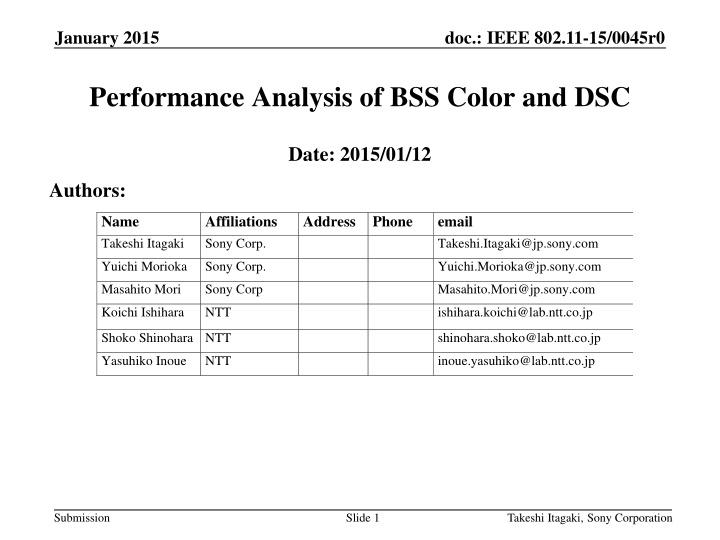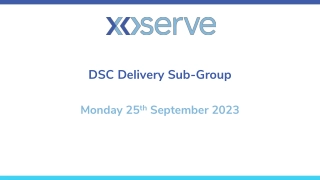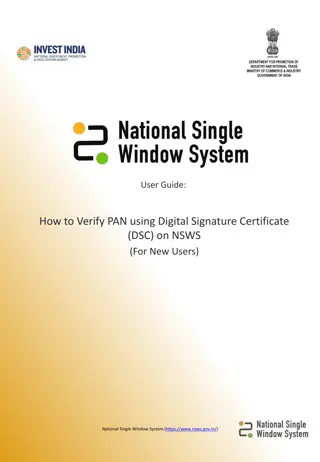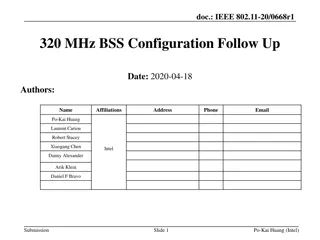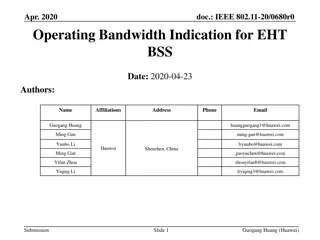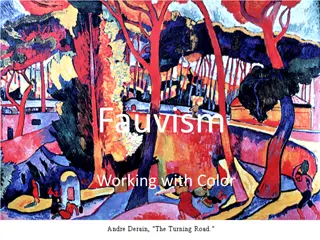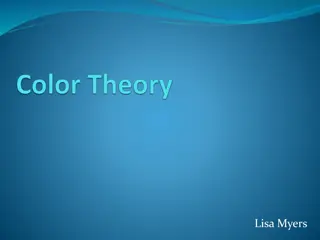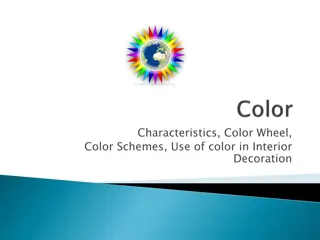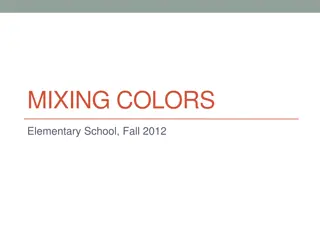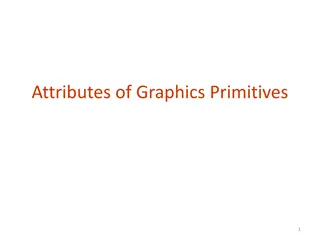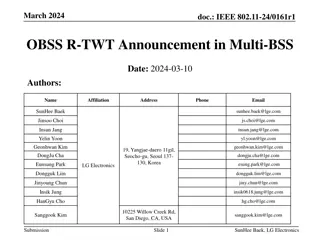Performance Analysis of BSS Color and DSC
Performance comparison of DSC vs. BSS Coloring with a focus on the impact on system simulation results and the potential gain when used in combination. The study evaluates the behavior of BSS Color and DSC algorithms, showcasing insights into packet filtering, deferral levels, and color assignment mechanisms in WLAN settings.
Download Presentation

Please find below an Image/Link to download the presentation.
The content on the website is provided AS IS for your information and personal use only. It may not be sold, licensed, or shared on other websites without obtaining consent from the author.If you encounter any issues during the download, it is possible that the publisher has removed the file from their server.
You are allowed to download the files provided on this website for personal or commercial use, subject to the condition that they are used lawfully. All files are the property of their respective owners.
The content on the website is provided AS IS for your information and personal use only. It may not be sold, licensed, or shared on other websites without obtaining consent from the author.
E N D
Presentation Transcript
January 2015 doc.: IEEE 802.11-15/0045r0 Performance Analysis of BSS Color and DSC Date: 2015/01/12 Authors: Name Takeshi Itagaki Affiliations Sony Corp. Address Phone email Takeshi.Itagaki@jp.sony.com Yuichi Morioka Sony Corp. Yuichi.Morioka@jp.sony.com Masahito Mori Sony Corp Masahito.Mori@jp.sony.com Koichi Ishihara NTT ishihara.koichi@lab.ntt.co.jp Shoko Shinohara NTT shinohara.shoko@lab.ntt.co.jp Yasuhiko Inoue NTT inoue.yasuhiko@lab.ntt.co.jp Submission Slide 1 Takeshi Itagaki, Sony Corporation
January 2015 doc.: IEEE 802.11-15/0045r0 Abstract Performance comparison of DSC vs. BSS Coloring has been shown through system simulation in [1] There is not so much gain if only BSS Coloring is used and DSC outperforms in the simulation When BSS Coloring is used with DSC it can increase gain when the offset of Rx sensitivity level is relatively small In the simulation, filtered packets by BSS color always cause BUSY until end of packets This time, BSS coloring with a second deferral level is considered After filtering OBSS packets, 11ax STA can transit to IDLE depending on this 2nd deferral level Performance of DSC vs. BSS Coloring (w/ 2nd deferral level) has been compared again in this contribution Submission Slide 2 Takeshi Itagaki, Sony Corporation
January 2015 doc.: IEEE 802.11-15/0045r0 BSS Color (Updated) A mechanism introduced in 802.11ah Assign a different color per BSS How a color is selected by the AP is not defined This color is indicated in the .11ah PHY Header In this simulation, the color information is assumed to be in HT/VHT-SIG without increasing number of bits of SIG Upon reception of a PPDU from an OBSS, i.e. with a different color, packet reception procedure may be abandoned STA that supports this feature is abled to add and compare color In this simulation, CCA after abandoning depends on the signal level Submission Slide 3 Takeshi Itagaki, Sony Corporation
January 2015 doc.: IEEE 802.11-15/0045r0 DSC Algorithm STA: Beacon RSSI based algorithm Compare the RSSI of the most recently received Beacon with Trigger Threshold and if exceed the threshold, toggle the state of Rx Sensitivity Level to Raised . Otherwise toggle the state to Default In this time Trigger Threshold is set to -41dBm Rx sensitivity level during Default is fixed to -82dBm Rx sensitivity level during Raised is a parameter (A dbm) CCA threshold is always -62dBm AP: Fixed AP s Rx sensitivity level is always set to A dBm CCA threshold is always -62dBm time Beacon Beacon Beacon Beacon AP -40dBm -50dBm -38dBm -40dBm Raised Rx Sensitivity Lv Default Rx Sensitivity Lv Raised Rx Sensitivity Lv STA Submission Slide 4 Takeshi Itagaki, Sony Corporation
January 2015 doc.: IEEE 802.11-15/0045r0 Behavior of DSC and BSS Color w/ 2nd Deferral Level [Note] Assume signal level of interference packet is lower than Rx sensitivity(DSC) / 2nd deferral Level(COLOR) [Note] Assume COLOR information is included in VHT-SIGA L&VHT SIG L-STF/ LTF VHT-STF/ LTF/SIGB PSDU OBSS STA s Tx (with different COLOR) not detected at all - Treated as CCA_IDLE -> can continue backoff procedure - Can receive another packet STA that enables DSC COLOR doesn t match -> abandon Rx and compare signal level with 2nd deferral level detected - Treated as CCA_IDLE -> can restart backoff procedure - Can receive another packet STA that enables COLOR filtering Rx PLCP DSC BSS COLOR filtering Increasing Tx opportunity Acquiring Rx opportunity for desired signal Can improve. Can improve. Can improve. (But only when the packet has COLOR) Can improve. (But only when the packet has COLOR) Submission Slide 5 Takeshi Itagaki, Sony Corporation
January 2015 doc.: IEEE 802.11-15/0045r0 Simulation Conditions Scenario-3 19-cell model with wrap-around (Reuse=3) Traffic model 10 uplink UDP Flows/BSS (Full-buffer condition) No downlink traffic MCS selection Goodput maximizing MCS based on SINR by training[3] Sensitivity control algorithm Beacon RSSI based algorithm[5] Parameters Method (DSC / BSS Coloring) Rx sensitivity level (DSC) or 2nd deferral level (BSS Coloring) -82dBm ~ -52dBm See backup slide for details 30m 10m Submission Slide 6 Takeshi Itagaki, Sony Corporation
January 2015 doc.: IEEE 802.11-15/0045r0 Performance Comparison DSC BSS Coloring w/ 2nd deferral level 60% Up 28% Up 15% Up 15% Up 8% Up 11% Up BSS Total Tput 165% Up per STA Tput 104% Up 39% Up 27% Up 27% Up 16% Up 23% Down 47% Down 49% Down 7% Up 4% Up 3% Up red...Ave blue...CDF5% Submission Slide 7 Takeshi Itagaki, Sony Corporation
January 2015 doc.: IEEE 802.11-15/0045r0 Performance Comparison [Note] Definition of Threshold for BUSY DSC: Rx sensitivity level (Raised state) BSS Color: 2nd deferral level The gain of BSS Color method is saturated and DSC has much gain. BSS Color method is slightly better than DSC. In almost all thresholds, the gain of DSC method is higher than BSS coloring method Submission Slide 8 Takeshi Itagaki, Sony Corporation
January 2015 doc.: IEEE 802.11-15/0045r0 Analysis - Difference of Rx Procedure DSC BSS Coloring w/ 2nd deferral level S >= Rx sensitivity Lv? S >= Rx sensitivity Lv? No No Yes Yes BUSY & Rx PLCP BUSY & Rx PLCP [NOTE] CCA th. = CCA threshold = -62dBm Does PLCP have no err? Yes Does PLCP have no err? No(PLCP err) IFS= EIFS IFS= EIFS In this case, S has already been high! (It depends on interference scenario) Y No(PLCP err) Yes No S+I >= CCA th.? No Is Color matched? IFS= Yes Y AIFS BUSY Rx Yes or IDLE BUSY have no color relatively S >= 2nd deferral Lv? rare No Packets that its signal level is lower than 2nd deferral level often have PLCP error in this simulation condition. (Full buffer condition very high interference level) S+I >= CCA th.? No BUSY Rx Yes Yes IDLE BUSY Submission Slide 9 Takeshi Itagaki, Sony Corporation
January 2015 doc.: IEEE 802.11-15/0045r0 Conclusion Performance of BSS Coloring and DSC has been compared in SS3 In almost all thresholds, the gain of DSC method is higher than BSS color method individually. One reason of different gain is PLCP error Other possible reason is that packets from legacy STA cannot be filtered by color. if these methods are used The possibilities of these methods (including combination) in other scenarios should be considered continuously. Submission Slide 10 Takeshi Itagaki, Sony Corporation
January 2015 doc.: IEEE 802.11-15/0045r0 References 1. Masahito Mori, Sony, 11-14-1403-00-00ax-Performance Analysis of BSS Color and DSC 2. William Carney, Sony, 11-14-0854-00 DSC and Legacy Coexistence 3. Gwen Barriac, Qualcomm, 11-14-0851-02-00ax-rate- control-for-mac-and-integrated-system-simulations 4. Hongyuan Zhang, Marvell, 11-14-0372-02-0hew-system- level-simulations-on-increased-spatial-reuse 5. Graham Smith, DSP Group, 11-13-1290-01 Dynamic Sensitivity Control for HEW 6. Matthew Fischer, Broadcom, 11-13-1207-01-00ah-partial- aid-color-bits Submission Slide 11 Takeshi Itagaki, Sony Corporation
January 2015 doc.: IEEE 802.11-15/0045r0 Appendix Submission Slide 12 Takeshi Itagaki, Sony Corporation
January 2015 doc.: IEEE 802.11-15/0045r0 Simulation Setup details (AP x 1, STA x 10) x 19 (Half of STAs are 11AX STA, and others are Legacy STA) Node 5 Num of Drops [times] Uplink CBR UDP 30Mbps (from all STA -> Full Buffer condition), 20sec Traffic Model & Load & Duration AC_BE CWmin=15, CWmax=1023, AIFSN=3, TXOP limit=0 Access Category AP:+23dBm(2 antennas), STA:+15dBm(1 antenna) Tx Power [dBm] Goodput maximizing MCS based on Training (MCS0 ~ 7) MCS Selection (MPDU, MSDU, APP)=(1030, 1000, 972) Fixed Packet Length [byte] 10 L2 Retry Legacy 6.0Mbps Ack Rate OFF RTS/CTS (A-MPDU, A-MSDU)=(8KB, NA) Max Aggregation Size 7 NF [dB] TGn Channel D (pathloss, shadowing, fading) Channel (CenterFreq, BW)=(2412, 20) Channel Setting [MHz] Parameter (-82 ~ -52: on 11ax-STAs & APs , -82 on Legacy-STAs) [NOTE] Only DSC method Rx sensitivity level [dBm] Parameter (-82 ~ -52: on 11ax-STAs & APs , -82 on Legacy-STAs) [NOTE] Only BSS Coloring method 2nd deferral level [dBm] -62 CCA sensitivity level [dBm] Enable (Error performance is shown in slide#14) Det. Cancel on PLCP err See slide #4 DSC algorithm AP and 11AX STA can handle COLOR information. (adding/filtering) STAs cannot filter packets that has no COLOR information (i.e. flow from Legacy STAs). BSS COLOR operation Submission Slide 13 Takeshi Itagaki, Sony Corporation
January 2015 doc.: IEEE 802.11-15/0045r0 Simulation Setup details Submission Slide 14 Takeshi Itagaki, Sony Corporation
